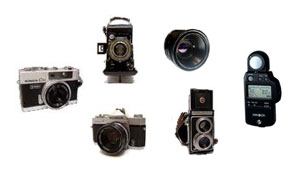
What is taking so long? The DSLR is big, heavy and slow but takes superb pictures, unfortunately accompanied by a loud, clacking sound. The mirrorless camera is small, light, fast and in some cases totally quiet and vibration-free. However it has difficulties matching the viewing clarity and image quality of the DSLR. Sony is coming close to matching DSLR IQ with its A7R, a full-frame, 36MP, compact, mirrorless camera. However, Sony made two mistakes in the design of the A7. Both have to do with trying to make the camera as compact as possible.
First: Sony pushed the lens as far into the camera as possible. This very short flange distance creates very acute light angles and associated light loss in the image corners. Had Sony settled for a more optimum flange distance, the IQ of the Sony A7R should have been comparable to that of the Nikon D800E which uses the same image sensor but without a compromise in flange distance and pixel optics.

The D800/Sigma35 records an overall image quality of 39 and a resolution of 23 P-Mpix (Perceptual Megapixel), while the A7R/Sigma35 records an overall image quality of 34 and a resolution of 17 P-Mpix.
Second Sony A7 mistake: the grip is too small. Even though the camera itself is more compact than a DSLR, the full-frame sensor dictates size and weight of lenses used. The grip should consequently not mimic the miniaturization of the camera, it should enable handling the weight of the entire package.
To keep from losing the charm of the very compact camera, why not a universal grip mount and a range of optional grip sizes.
Now that we got that out of the way, let’s design the ultimate camera. And instead of waiting for further breakthroughs in EVFs and image sensor PDAF, let’s fuse existing technology into a functionally ultimate camera.
This will not be a pocket camera. There are already plenty of those. It will be a DSLR size camera with a mirrorless camera function built in. It will have two modes of operation: the DSLR mode and the high-speed, mirrorless CC — or Copy Cat mode.
In DSLR mode it will work like a high-end DSLR doing PDAF autofocus and mirrored light metering, except it will also store light metering and focus point data for possible later use.
Your first image in each burst is consequently an ordinary DSLR image. If you now keep your finger on the shutter release the camera goes into CC mode where the mirror stays out of the way and the images following thereafter are controlled by the image sensor.
If the light metering done by the image sensor does not change and the part of the image that represents the focus point does not lose focus, nothing will change. Aperture, exposure and ISO will remain unchanged while the camera takes a rapid, quiet and vibration free succession of images.
However, if the lighting changes, the camera will adjust the exposure to restore the lighting as seen by the image sensor to equal that of the first image.
Furthermore, if the in focus details go out of focus the camera will adjust the auto-focus to bring the originally chosen details back into focus.
So what’s the hold-up?
Canon, Nikon and others, put your thinking caps on and let us see some innovation and progress.
Please.


